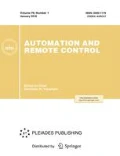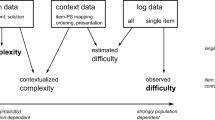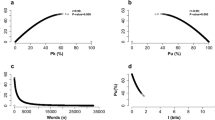Abstract
We suggest a routine for automatic estimation of complexity and difficulty of educational tasks. This routine is based on syntactic text analysis, phrases’ predicative structures identification, and semantic network construction. Then we develop a mathematical model which employs a notion on semantic distance between notions–words to calculate the amount of knowledge in a semantic network. We show that the amount of knowledge in a semantic network is a measure in the set of all semantic networks, and the semantic distance makes this set the metric one.
Similar content being viewed by others
References
Avanesov, B.S., Knowledge as a Studies Course of Pedagogical Measuremnts, Pedagogich. Izmeren., 2005, no. 3, pp. 43–52.
Anisimov, A.V., Liman, K.S., and Marchenko, A.A., Methods of Computing Measures of Words Semantic Similarity in a Natural Language, URL: http://lingvoworks.org.ua (Cited April 9, 2013).
Borisov, I.K., Optimizatsiya protsessa obucheniya: Obshchedidakticheskii aspekt (Optimization of Education Process. Common Pedagogical Aspect), Moscow: Pedagogika, 1977.
Ball, G.A., Teoriya uchebniykh zadach: psikhologo-pedagogicheskii aspekt (Educational Tasks Theory: Psychological-and-Pedagogical Aspect), Moscow: Pedagogika, 1990.
Belonogov, G.G., Komp’yuternaya lingvistika i perspektivnye informatsionnye tekhnologii (Computational Linguistics and Advanced Information Technology), Moscow: Russkii Mir, 2004.
Braslavski, P.I. and Sokolov, E.A., Comparison of Five Methods for Variable Length Term Extraction, Tr. mezhd. konf. “Dialog 2008” (Proc. Int. Conf. “Dialog 2008”), 2008, pp. 67–74.
Vagin, V.N., Golovina, E.Yu., Zagoryanskaya, A.A., and Fomina, M.V., Dostovernyi i pravdopodobnyi vyvod v intellektual’nykh sistemakh (Exact and Plausible Inference in Intelligent Systems), Moscow: Fizmatlit, 2008.
Valgina, N.S., Rosenthal’, D.E., and Fomina, M.I., Sovremennyi russkii yazyk: uchebnik (Modern Russian Language: Textbook), Valgina, N.S., Ed., Moscow: Logos, 2002.
Gavrilova, T.A. and Khoroshevsky, V.F., Bazy znanii intellektual’nykh sistem (Knowledge Bases of Intelligent Systems), St.-Petersburg: Piter, 2000.
Danil’yan, O.G. and Panova, N.I., Sovremennyi slovar’ po obshchestvennym naukam (The Modern Dictionary on Social Studies), Moscow: Eksmo-Press, 2007.
Evstigneev, V.A., Primenenie teorii grafov v programmirovanii (Application of Graph Theory to Programming), Moscow: Nauka, 1985.
Ermakov, A.E., Knowledge Extraction from Text and Its Processing: Current State and Prospects, Inform. Tekhn., 2009, no. 7, pp. 50–55.
Efremova, N.F., Testovyi kontrol’ v obrazovanii: uchebnoe posobie (Test Control in Education: Textbook), Moscow: Universitetskaya Kniga, 2007.
Karpenko, A.P. and Sokolov, N.K., The Semantic Net Complexity Measures in Learning System, Vestn. MGTU, Ser. Priborostr., 2009, no. 1(74), pp. 50–66.
Karpenko, M.P., The Problem of Measurement of Knowledge and Education Technologies, Zh. Prakt. Psikhol., 1997, no. 4, pp. 74–79.
Kravtsov, L.G., Methodological Problems in Psychological Analysis of Thought in Notions, Mater. I Ros. konf. kogn. nauke (Mat. 1st Rus. Conf. Cogn. Sci.), Kazan: Kazan. Gos. Univ., 2004, URL: http://www.ksu.ru/ss/cogsci04/science/cogsci04/sod.php3 (Cited November 22, 2013).
Krasnykh, V.V., Osnovy psikholingvistiki i teorii kommunikatsii (Fundamentals of Psycholinguistics and Theory of Communication), Moscow: Gnosis, 2012.
Lerner, I.Ya., Complexity Factors in Cognitive Problems, Nov. Issled. Pedagog. Nauk., 1970, no. 1, pp. 86–91.
Luger, G.F., Artificial Intelligence: Structures and Strategies for Complex Problem Solving, London: Addison-Wesley, 2002. Translated under the title Iskusstvennyi intellekt: strategii i metody resheniya slozhnykh problem, Moscow: Vil’yams, 2005.
Mikk, Ya.A., Optimizatsiya slozhnosti uchebnogo teksta: v pomoshch’ avtoram i redaktoram (Optimization of Complexity of the Educational Text: For the Aid to Authors and Editors), Moscow: Prosveshchenie, 1981.
Mitrofanova, O.A., Semantic Distances: Problems and Prospects, XXXIV Mezhd. filolog. konf: Vypusk 21. “Prikladnaya i matematicheskaya lingvistika” (34 Int. Phil. Conf.: Issue 21. “Applied and Mathematical Linguistics”), St.-Petersburg, 2005, pp. 59–63.
Multifunctional Linguistic Processor ETAP-3, URL: http://www.iitp.ru/ru/science.
Naikhanova, L.V., Tekhnologiya sozdaniya metodov avtomaticheskogo postroeniya ontologii s primeneniem geneticheskogo i avtomatnogo programmirovaniya (Technology of Creating Methods for Automatic Construction of Ontology Using Genetic and Automata-Based Programming), Ulan-Ude: BNTs,, 2008.
Novaya filosofskaya entsiklopediya (New Encyclopaedia of Philosophy), 4 vols., Moscow: Mysl’, 2010, URL: http://iph.ras.ru/enc.htm (Cited April 9, 2014).
Noveishii filosofskii slovar’ (Newest Philosophical Dictionary), Minsk: Knizhnyi Dom, 2003, 3rd ed.
Pogorelov, A.V., Geometriya: uchebnik dlya 7–11 klassov obshcheobrazovatel’nykh uchrezhdenii (Geometry: Textbook for Secondary School), Moscow: Prosveshchenie, 1995.
Popov, E.V., Obshchenie c EVM na estestvennom yazyke (Natural Language Interaction with Computers), Moscow: Nauka, 1982.
Romadina, O.G. and Rakitina, E.A., Procedure of the Estimation of Complexity of Educational Problems on Computer Science, Vopr. Sovrem. Nauki Prakt., 2010, no. 10–12(31), pp. 146–151.
Ryzhenko, N.G., Graphic Modeling as a Method for Defining Complexity of Solutions to School Text Problems, Matem. Inform., Omsk, 2001, issue 1, pp. 99–103.
Fedotov, I.E., Nekotorye priemy parallel’nogo programmirovaniya: uchebnoe posobie (Some Methods of Parallel Programming: Textbook), Moscow: MGIREA, 2008.
Filippovich, Yu.N. and Prokhorov, A.V., Semantika informatsionnykh tekhnologii: opyty slovarnotezaurusnogo opisaniya (Semantics of Information Technologies: Experience of Dictionary-Thesaurus Description), Moscow: MGUP, 2002.
Collins-Tompson, K., Bennett, P., White, R., Chica, S., and Sontag, D., Personalizing Web Search Results by Reading Level, Proc. 20th ACM Int. Conf. on Information and Knowledge Management, New York, 2011, pp. 403–412.
Dubay, W., The Principles of Readability, Costa Mesa: Impact Information, 2004.
Hartley, R.V.L., Transmission of Information, Bell Syst. Tech. J., 1928, July, pp. 535–563.
Leacock, C. and Chodorow, M., Combining Local Context and WordNet Similarity for Word Sense Identification, in WordNet: An Electronic Lexical Database, Fellbaum, C., Ed., Boston: MIT Press, 1998, pp. 265–283.
Patwardhan, S., Banerjee, S., and Pedersen, T., UsingMeasures of Semantic Relatedness forWord Sense Disambiguation, Proc. 4th Int. Conf. on Intelligent Text Processing and Computational Linguistics, 2003, pp. 241–257.
Shannon, C.E., A Mathematical Theory of Communication, Bell Sys. Tech. J., 1948, vol. 27, pp. 379–423, 623–656.
Anisimovich, K.V., Druzhkin, K.Ju., Minlos, F.R., Petrova, M.A., Selegey, V.P., and Zuev, K.A., Syntactic and Semantic Parser Based on ABBYY Compreno Linguistic Technologies, in Kom’yuternaya lingvistika i intellektual’nye tekhnologii (Computer Linguistics and Intellectual Technologies), 2012, pp. 810–822, URL: http://www.dialog-21.ru/digests/dialog2012/materials/pdf/Anisimovich.pdf (Cited December 2, 2013).
Author information
Authors and Affiliations
Corresponding author
Additional information
Original Russian Text © I.S. Naumov, V.S. Vykhovanets, 2014, published in Upravlenie Bol’shimi Sistemami, 2014, No. 48, pp. 97–131.
Rights and permissions
About this article
Cite this article
Naumov, I.S., Vykhovanets, V.S. Using syntactic text analysis to estimate educational tasks’ difficulty and complexity. Autom Remote Control 77, 159–178 (2016). https://doi.org/10.1134/S0005117916010100
Received:
Published:
Issue Date:
DOI: https://doi.org/10.1134/S0005117916010100




